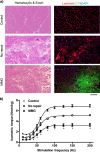Multiscale analysis of a regenerative therapy for treatment of volumetric muscle loss injury
- PMID: 29531830
- PMCID: PMC5841404
- DOI: 10.1038/s41420-018-0027-8
Multiscale analysis of a regenerative therapy for treatment of volumetric muscle loss injury
Erratum in
-
Correction: Multiscale analysis of a regenerative therapy for treatment of volumetric muscle loss injury.Cell Death Discov. 2018 Jul 23;4:16. doi: 10.1038/s41420-018-0080-3. eCollection 2018. Cell Death Discov. 2018. PMID: 30062061 Free PMC article.
Abstract
Skeletal muscle possesses a remarkable capacity to regenerate when injured, but when confronted with major traumatic injury resulting in volumetric muscle loss (VML), the regenerative process consistently fails. The loss of muscle tissue and function from VML injury has prompted development of a suite of therapeutic approaches but these strategies have proceeded without a comprehensive understanding of the molecular landscape that drives the injury response. Herein, we administered a VML injury in an established rodent model and monitored the evolution of the healing phenomenology over multiple time points using muscle function testing, histology, and expression profiling by RNA sequencing. The injury response was then compared to a regenerative medicine treatment using orthotopic transplantation of autologous minced muscle grafts (~1 mm3 tissue fragments). A chronic inflammatory and fibrotic response was observed at all time points following VML. These results suggest that the pathological response to VML injury during the acute stage of the healing response overwhelms endogenous and therapeutic regenerative processes. Overall, the data presented delineate key molecular characteristics of the pathobiological response to VML injury that are critical effectors of effective regenerative treatment paradigms.
Conflict of interest statement
The authors declare that they have no competing interests.
Figures






Comment in
-
Robust inflammatory and fibrotic signaling following volumetric muscle loss: a barrier to muscle regeneration.Cell Death Dis. 2018 Mar 14;9(3):409. doi: 10.1038/s41419-018-0455-7. Cell Death Dis. 2018. PMID: 29540673 Free PMC article. No abstract available.
References
Grants and funding
LinkOut - more resources
Full Text Sources
Other Literature Sources
Molecular Biology Databases

